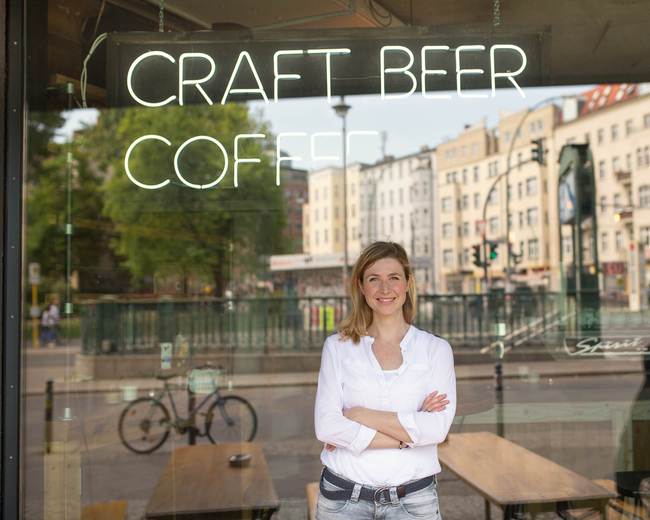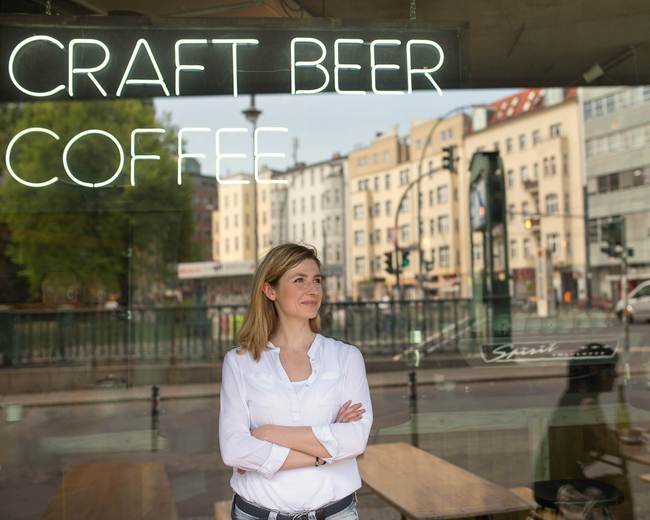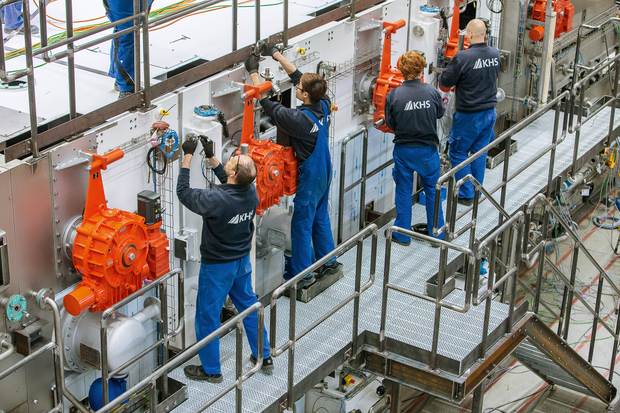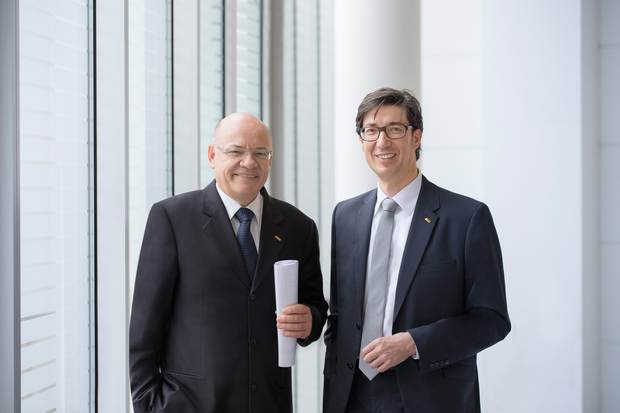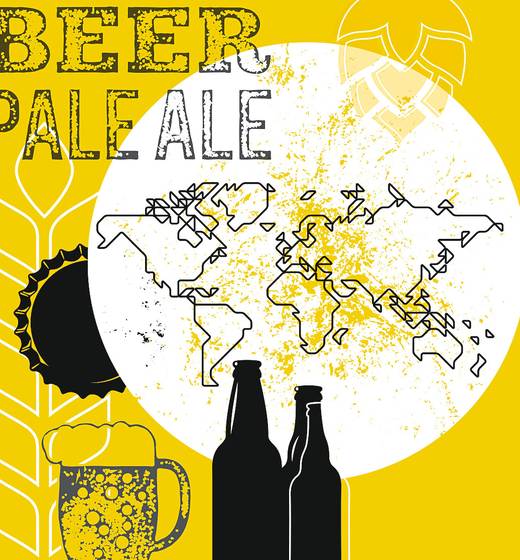There are a not inconsiderable number of people who still consider craft beer to be a short-sighted marketing ploy or even a niche product made by weirdos for weirdos. How long do you think this phenomenon will last, Ms. Klotz?
Craft beer is here to stay. In the USA, where the trend originally started, in figures it already has a market share of 20%. This is no longer a niche but a pretty big slice of the cake. More and more people are thinking about where their food comes from and what they eat. We’re seeing this with meat, fruit, and vegetables as well as bread which we try to source from a baker who actually still makes his own. Effectively we’re always looking for the same thing: a transparent product which is handmade to a certain extent, the makers of which the consumer knows. This zeitgeist also applies to beer. The conscious consumer no longer wants beer that rolls off an anonymous conveyor belt somewhere but a beverage where the brewer puts a face to the product.
Craft beer is thus a visible expression of the megatrend for neo-ecology. Does the same not apply to the beers produced by our small, traditional breweries?
Absolutely. And with the great attention craft beer is being paid it’s like a kind of concave mirror which casts light back onto the traditional breweries. Take someone who’s just drunk a “Rauchbier” (smoked beer) in California, for instance, which he found cool and exciting. Back in Germany he realizes that you can get this here, too – namely in Franconia. Thus the interest in our small, long-established craft breweries grows, among which are many hidden champions or brewers who produce extremely good beers without making a big fuss about it. With young Germans suddenly developing a new awareness of beer, many traditional brewers who were rather reserved about craft beer at first now recognize which value this trend is also creating for them. And this is also good for them.
What do you specifically mean by ‘creativity’ when brewing beer?
It’s what distinguishes the craft brewer from the medium-sized entrepreneur in Franconia, for example, who’s been brewing his lager without change for generations – and little else. I don’t assess creativity by the style of a beer, however; a company which makes an IPA* isn’t automatically a craft brewery. Rather, it’s the other way round: in Munich, for example, Tilmans Biere makes a lager which is very good and tastes quite different from other traditional Munich lagers. This is a real craft brewer. I think a craft beer should stand out from the average-tasting beer and have so much character that even an inexperienced beer drinker could distinguish it from other mainstream pilsners.
* Editor’s note: IPA = India Pale Ale
How are the big breweries reacting to the craft beer trend?
Radeberger hasn’t reacted but acted by being one of the first to produce a craft beer which goes by the name of Braufactum. Bitburger makes special, very good beers in small batches under its Craftwerk sub-brand, such as a Belgian-style Tripel or an IPA. Becks hasn’t actually created its own brand but instead introduced a series entitled “Taste the World” which is sold in supermarkets and by discounters. The Nordmann Group is a special case in point, originally a beverage wholesaler which owns Ratsherrn in Hamburg and Störtebeker in Stralsund. This company of course has a perfect logistics setup. In an act of solidarity, it has now opened its own restaurants “Das alte Mädchen” in Hamburg and “Das Doldenmädchen” in Berlin which not only promote Nordmann beers but other craft beers as well. These are all examples which show that the big companies have realized that they need to act.
Do you see any anomalies between the German Purity Law on the one hand and craft beer on the other?
The craft beer movement is often presented as forming an opposite pole to the Purity Law – which it doesn’t actually want to be. Most craft beers are in fact brewed according to the “Reinheitsgebot” or German Purity Law – some because brewers don’t want to have to apply for a special permit and others because they don’t have to for the types of beer they want to brew, such as IPA, for example. Most styles of beer are compatible with this law. Some craft brewers even see the Purity Law as a challenge; they want to prove that by simply selecting the right type of hop and applying their particular brewing skills they can produce a beer which has an intensive taste of grapefruit without any grapefruit actually being in it. There are also a few who deliberately position themselves as anti-Purity Law brewers, however, with their Belgian fruit beers or the spices they add to their beers.
What consequences must these brewers reckon with?
Except in Bavaria this is actually relatively unimportant as you merely have to apply for special dispensation to brew “special beers”, as they’re officially called, and this is usually granted. This means a certain amount of paperwork and also costs a bit but brewers are happy to take this on board – here in Berlin, too, where they make a framboise – that’s a raspberry beer – and other great things. The only place this isn’t possible is in Bavaria. There was even a precedent here, where the Camba Bavaria brewery in Truchtlaching had to destroy a batch of milk stout as the beer was fermented with lactose according to tradition and this didn’t conform to the Purity Law.
“The big breweries have realized they need to act.”
“More and more craft brewers can now guarantee to supply retail chains on a regular basis.”
Is the German Purity Law set in stone for all time in your opinion?
The associations see a certain need for action, namely to adapt the German Purity Law or the Provisional Beer Law from 1993 so that the additional use of other natural ingredients is also permitted in Bavaria. Brewers who wish to flavor their beer with orange peel or coriander aren’t adulterators but just people who want to make beers more creatively than we have done to date.
What chances, then, has craft beer on a market which has been clearly shrinking for years?
It’s interesting that thanks to its variety craft beer can even generate new market potential by reaching out to people who up to now have only associated beer with pilsner – which they perhaps haven’t taken a real liking to. If somebody like this tries a chocolate stout, for instance, he or she may notice that this is an interesting product with a totally different taste. There are already statistics which show that the decline in beer consumption is slowing down or even stagnating. The new beers undoubtedly have their part to play in this.
Is there already something of a market consolidation among craft brewers?
We still have to see the first craft brewery being taken over by a brewery group in Germany. This is happening all the time in the USA at the moment. It remains to be seen which negative consequences this will have there: whether brewers will still have the freedom to produce their beer in the accustomed quality under the new owners, for example. One danger for small businesses might be that when distributing their mainstream beer to supermarket chains the big breweries make it a condition that the craft beers which also belong to the group are included in the portfolio. The refrigerator would then be full and there’d be no more room for local beers – which would then have a marketing problem. The craft brewers in the USA are thus already heavily relying on local distribution – at the very least direct sale from the brewery and the small bar usually affiliated with it. This gives you very different margins, of course – and if you can generate enough from this, you can retain some of your independence.
You described craft beer as a handmade product. How much manual skill is actually involved and what type of equipment is used to make it?
As soon as a craft brewer goes professional and moves away from being a home or hobby brewer, the real craftsmanship stops. Most start as gypsy brewers, working with equipment they do not own. They then purchase their first own fermentation tank which may be located at another brewery and at some point there’s enough to buy a small brewhouse. They only procure their own filling system once a certain level has been reached. Until then they drive around and use systems at private breweries which happen to be running empty. As ideal packaging the can is gaining in popularity as it protects the beer from light and oxygen – like a small keg, if you will. In Germany – and only in Germany – canned beer has a negative image but those who are bold enough can use the can to set themselves apart from the competition. There’s a lot happening here but it’s not easy for craft brewers to find canners who also process small batches.
How will the market for craft brewers develop in the future?
There are now special beer distributors who introduce craft beer – which requires some explanation – to both the hospitality and retail trades. Supermarket chains EDEKA and REWE are now filling their first shelves with local beers. This is an important step forward for small breweries; here, they can also gain totally normal customers who buy a case of their beer again and again – instead of always hunting down the latest product like some kind of nerd.
More and more craft brewers can now guarantee to supply retail chains on a regular basis either by hiring space per brew at larger breweries as what are known as gypsy brewers or by carefully building up their own capacities. BRŁO, for example, is building a large-scale brewery in the middle of Berlin with a taproom and beer garden and their pale ale is offered on Air Berlin flights. This boosts the brand’s popularity. These are the right steps to take in my opinion. I’d like brewers to come out of their beer closets a bit more and grab new customers in the food retail trade who may not know a lot about craft beer at the moment but who are receptive to it. Unfortunately, many have failed to do so to date.
The interview was conducted by KHS competence editor Stuart J. Nessbach.




















